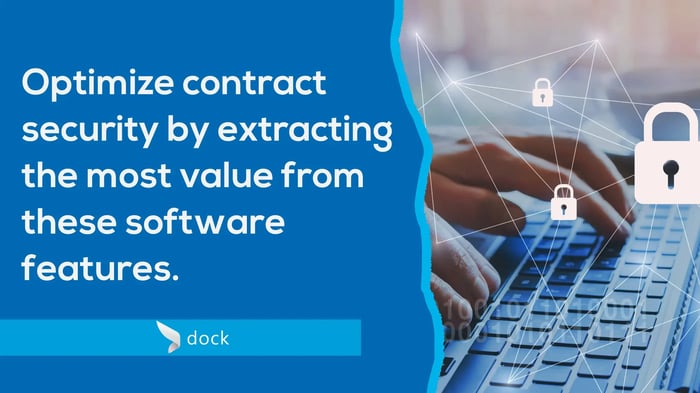
Top Contract Management Software Security Features
Contracts contain the most critical confidential information and agreement terms. Ensuring that your contract lifecycle management (CLM) software is equipped with the best available security features is the key to secure contract management. And as we approach 2022, we recommend taking some time to assess the security settings provided by your CLM software so that you can make the most of your contracting platform.
Contract security should be a part of your organization’s contract management and legal strategy, where you leverage all of the following tools to standardize your contract operations. It’s clear that employing optimal security procedures from the get-go supports your company in maximizing contract security.
As previously mentioned, the entirety of your organization’s most confidential and sensitive data, from financial details to client information to non-disclosure agreements, are found within your contracts. The majority of companies restrict access to internal software locations and email apps; however, few invest their efforts towards the security of the contracts themselves. And the result? Breaches of data and subpar contract lifecycle management security in companies ranging from small businesses to massive, enterprise-level organizations. You might wonder how to optimize contract security while maintaining efficiency, proper contract accessibility, and appropriate levels of contract transparency. We take a deep dive into this topic below.

Now, let’s take a look at some contract management software security features to keep an eye out for when you adopt your next contract management system or when determining the security level of your current system:
Content-
- Audit Trails
- Single Sign-On
- Multi-Factor Authentication
- Passwords
- Permissions-based Access
- Software Configuration
- Licenses
- Electronic Signature Integrations
- Cloud-based Platform
- Vulnerability Testing
- Conclusion
Audit Trails
Keeping comprehensive logs from audit trails is a great way to increase contract security. With these logs, you can view contract communications, user activities, and confirm that your contracts are secure while maintaining an appropriate level of visibility. When a contract is signed and fully executed, contract managers can easily assess a detailed record of every contract version, communication, and user activity pertaining to the contract at hand – giving them the control to review contract compliance at every step.
Single Sign-On
Has your organization implemented single sign-on (SSO) to increase efficiency and security of logins into different apps? If not, we highly recommend making the effort to adopt and use this security feature. Here at Dock, we offer SSO as a key element of your contract security strategy.
Multi-Factor Authentication
Multi-factor authentication is one of the most common security features adopted by software solutions across the board. Adding this to your security repertoire can support you in mitigating invasions of data. Because this security feature is so widely used, many have familiarity with its functionalities, making it an easy feature to being using within your organization.
Passwords
When was the last time you reviewed your organization’s password policy? Has it changed since the large-scale transition remote work? We suggest requiring long passwords of a minimum of 8 characters with a mixture of characters. In addition, it is best practice to reduce the frequency of password updates.
Permissions-based Access
Permissions settings can help you ensure that only the right people can review and edit select documents. With this feature, you can assign roles for your employees in various departments and limit access appropriately. For more on all things permissions-based access, check out our previous blog here.
Software Configuration
I’m sure you’re familiar with the headache of forgetting your password, attempting to remember it, trying your guesses, and then getting locked-out of the system. Has this happened to your employees? Oftentimes, software will allow for 3 attempts prior to locking users out of the system. Are you currently aware of how long the lock-out period is for your system? If your organization is experienced with attempted hacking, the best practice is to configure the lock-out period for 30 to 60 minutes to reduce the likelihood for continued attempts.
Licenses
Once you’ve begun assessing the state of your contract management software’s security settings, take a look at which users have licenses. In the case of scenarios like leaves of absence, job changes, and other relevant adjustments, you need to review which users are consistently working on the app and if they should change their license. We suggest making notations of which users require an update or suspension of license.
Electronic Signature Integrations
Here at Dock, we offer integrations with leading electronic signature providers like DocuSign, Sertifi, and Adobe Sign. Ensure that the right employees have access to your e-signature integrations so they can independently work through all required steps in the contract signing stage. Electronic signatures are also highly secure, far more than manual wet signatures. Electronic signatures leverage data hashing and contain a digital trail and record of who signed which document, and when.
Cloud-based Platform
A cloud-based infrastructure supports your contract managers and administrators with the ability to make swift changes to security procedures and policies. In addition, the cloud makes it easy to track software use companywide.
Vulnerability Testing
External testing and auditing help identify and expose areas of risk that are likely to be taken advantage of by hackers. We suggest adopting a contract lifecycle management solution that tests system penetration and vulnerability on a quarterly or yearly basis.
Conclusion
Contract lifecycle management software is the key to efficient and productive contract management. However, leveraging contract management software security tools, understanding the complexity of each, and having the knowledge to employ them appropriately can support you in the most secure and risk-mitigative approach possible towards your organization’s contracts. Just like we have to change the batteries in our smoke detectors, we have to regularly review our contract lifecycle management software security features.
Today, you can gain the upper hand on your contract cybersecurity approach with us here at Dock 365. We’ll support you with an intuitive, user-friendly contract lifecycle management (CLM) solution that will drive revenue, mitigate risk, and increase the value of your contract lifecycle management. If you’re ready to experience the benefits of contract management software for your business, then we’re here to help you at Dock 365.
Schedule a free demo with us today for an interactive overview of our Contract Management System.
Book a Live demo
Schedule a live demo of Dock 365's Contract Management Software instantly.

Written by Lindsey Paulk
Lindsey Paulk is a Content Writer in Jacksonville, Florida that specializes in digitally communicating all-things contract management.



